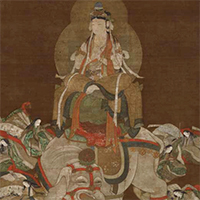仏教の美術―平安~室町
-

普賢十羅刹女像(部分) 鎌倉時代・14世紀
本館 3室
2018年4月24日(火) ~ 2018年5月27日(日)仏教美術は日本美術を代表するジャンルの一つです。その内容は多岐にわたり、各時代ごとに特色ある作品が生み出されてきました。
絵画は法華経関係の作品を中心に、また書跡は平安時代後期の法華経の優品を展示します。彫刻は浄土教信仰を代表する阿弥陀如来立像を展示します。工芸は前回に引き続き那智経塚出土の金銅三昧耶形などを展示します。
| 指定 | 名称 | 員数 | 作者・出土・伝来 | 時代・年代世紀 | 所蔵者・寄贈者・列品番号 | 備考 | |
| 阿弥陀如来立像 | 1躯 | 鎌倉時代・13~14世紀 | C-321 | ||||
| 木版両界曼荼羅図 | 2幅 | 南北朝時代・14世紀 | A-11891 | ||||
| 法華曼荼羅図 | 1幅 | 鎌倉時代・13世紀 | 岡崎正也氏寄贈 A-10163 | ||||
| 普賢菩薩像 | 1面 | 鎌倉時代・13世紀 | 個人蔵 | ||||
| 観音三十三応身図 | 1幅 | 室町時代・15世紀 | A-110 | ||||
| 釈迦三尊十羅刹女像 | 1幅 | 鎌倉時代・14世紀 | 遠藤久雄氏寄贈 A-10432 | ||||
| おすすめ | 普賢十羅刹女像 | 1幅 | 鎌倉時代・14世紀 | A-11790 | |||
| 宝塔絵曼荼羅 | 1幅 | 室町時代・16世紀 | 広島・妙政寺蔵 | ||||
| おすすめ | 重美 | 妙然尼像 | 1幅 | 永禄7年(1564)日叙賛 | 室町時代・16世紀 | A-10495 | |
| 国宝 | 線刻蔵王権現像 | 1面 | 奈良県吉野郡天川村金峯山出土 | 平安時代・長保3年(1001) | 東京・西新井大師総持寺蔵 | ||
| おすすめ | 重文 | 拾遺古徳伝絵巻 巻第三 | 1巻 | 鎌倉時代・元亨3年(1323) | 茨城・常福寺蔵 | ||
| 色紙華厳経 | 1巻 | 平安時代・12世紀 | B-2482 | ||||
| おすすめ | 重文 | 法華経分別功徳品 | 1帖 | 鎌倉時代・建長5年(1253) | 滋賀・宝巌寺蔵 | ||
| おすすめ | 国宝 | 法華経巻第四(浅草寺経) | 1巻 | 平安時代・11世紀 | 東京・浅草寺蔵 | ||
| 妙法蓮華経文句 巻第四上 断簡(唐紙経切) | 1幅 | 平安時代・11世紀 | B-12-5 | ||||
| 無量義経十功徳品第三断簡(愛知切) | 1幅 | 伝藤原行成筆 田中親美旧蔵 | 平安時代・11世紀 | B-3484 | |||
| 銅独鈷鈴 | 1口 | 和歌山県東牟婁郡那智勝浦町那智山出土 | 平安時代・12世紀 | 北又留四郎氏他2名寄贈 E-14870 | |||
| 銅三鈷鈴 | 1口 | 和歌山県東牟婁郡那智勝浦町那智山出土 | 平安時代・12世紀 | 北又留四郎氏他2名寄贈 E-14868 | |||
| 銅五鈷鈴 | 1口 | 和歌山県東牟婁郡那智勝浦町那智山出土 | 平安時代・12世紀 | 北又留四郎氏他2名寄贈 E-14871 | |||
| 銅塔鈴 | 1口 | 和歌山県東牟婁郡那智勝浦町那智山出土 | 平安時代・12世紀 | 北又留四郎氏他2名寄贈 E-14869 | |||
| 銅宝珠鈴 | 1口 | 和歌山県東牟婁郡那智勝浦町那智山出土 | 平安時代・12世紀 | 北又留四郎氏他2名寄贈 E-14874 | |||
| 金銅三昧耶形 | 1式 | 和歌山県東牟婁郡那智勝浦町那智山出土 | 平安時代・12世紀 | 北又留四郎氏他2名寄贈 E-14880 | |||
| 金銅大日如来 | 1躯 | 和歌山県東牟婁郡那智勝浦町那智山出土 | 平安時代・12世紀 | 北又留四郎氏他2名寄贈 E-14924 | |||
| 法波羅蜜菩薩 | 1躯 | 和歌山県東牟婁郡那智勝浦町那智山出土 | 平安時代・12世紀 | 北又留四郎氏他2名寄贈 E-14854 | |||
| 羯磨波羅蜜菩薩 | 1躯 | 和歌山県東牟婁郡那智勝浦町那智山出土 | 平安時代・12世紀 | 北又留四郎氏他2名寄贈 E-14855 | |||
| 無量寿如来 | 1躯 | 和歌山県東牟婁郡那智勝浦町那智山出土 | 平安時代・12世紀 | 北又留四郎氏他2名寄贈 E-14856 | |||
| 金剛波羅蜜菩薩 | 1躯 | 和歌山県東牟婁郡那智勝浦町那智山出土 | 平安時代・12世紀 | 北又留四郎氏他2名寄贈 E-14857 |
